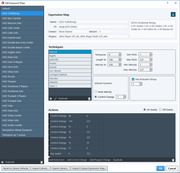First thing to check:
Since some instruments use sticky key-switches (the last one tapped sticks until a different one is tapped), it’s a good idea to always have a ‘Natural’ technique included in the expression map. Notes with no technique(s) attached get a ‘natural’ node.
Here’s an example for a Garritan (GPO5) Sound I’ve been using. In this case I want to send all this stuff as the ‘default’ or ‘natural’ state (a plain arco bowing style).
- It makes sure the Legato pedal (CC68) is off.
- I make adjustments to the start time in the sample with CC119.
- I’ve got more events to adjust a tonal filter, make sure the ‘mute’ is off, and adjust the ADSR settings.
- I send the proper key-switch for a regular arco bowing sound.
For this particular instrument, I send this entire slate of events (with different values) for pretty much every different technique Dorico offers, as well as various combinations of techniques such as legato+tenuto, and so forth. I add them and tweak as needed to a score…things can be quite different from score to score depending on style/tempo/etc. I.E. A downbow can change CC119 to play the sample a little earlier (where the bow starts grabbing), and changes ADSR somewhat for a more downbow effect. Because so many parameters get moved about when playing different articulations/styles, I just send the entire slate every time something needs to change.
So, if the expressionmap that causes you trouble already has a “Natural” technique, make sure it sends the right key-switch (or program change, etc.), and double check that the range and velocity limits, or length/duration percentages haven’t perhaps been clamped off by accident. If the expressionmap does not have a Natural technique, make one that will at least send the default key-switch.
If your expressionmap/plugin combo makes a lot of live dynamic changes to an assortment of parameters, be sure to reset them ‘all’ exactly how you’d like them for the default/natural sound.
Next thing to check
Sometimes a note can have more than one technique associated with it. I.E. It might have a slur over it, as well as a dot over it, thus it could trigger a “legato+staccato” expressionmap technique. So, double check in the score, that it’s not trying to trigger some sort of multi-node technique that is missing, or isn’t set up properly.
To build such a ‘combo technique’, hold the ctrl key while selecting more than one node when assigning nodes to a new technique. I.E. legato+marcato

If one unfolds things in Play View, and the instruments/players are properly pointing to a valid expressionmap, one can see a status bar with the piano scroll roll that shows any valid playing techniques, which also happen to have matching techniques in the expressionmap. Notes with cominbations of techniques will show an astrix (*), and hovering over that with a mouse will show all the active nodes. This status bar can really come in handy when trying to troubleshoot an expressionmap!
Sometimes I get odd combinations of techniques on my score, and there’s nothing even remotely close to the way I want it to sound assigned in my expressionmap. Or maybe it is falling back to something close, but not really what I have in mind. So, I find it’s not unusual at all for me to make a lot of combo techniques in the expressionmap on an ‘as need’ basis for each project. Sometimes I even find myself borrowing techniques meant for other instruments an hiding them from view in order to produce a ‘combi’ that will trigger the specific sound I need. I.E. I could make some wild combo like “legato+accent+staccato+mute+snares on” to force a certian set of ‘one off’ instrument parameters for a given piece. I’d simply hide the snares off technique in the score by setting it to full transparent.

